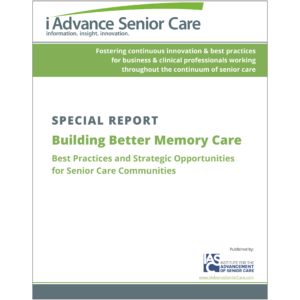Loneliness, helplessness, and boredom
Bill Thomas, MD, founder of the Eden Alternative, has familiarized the hallmarks of institutionalization—loneliness, helplessness, and boredom—reminding us that these are the constant companions of far too many nursing home residents. Over the past two months, I have become intimately familiar with these horrible feelings. I have been 700 miles away from my family, friends, and familiar haunts, undergoing training supposedly designed to make me a better administrator. What I have learned first and foremost, however, is not how better to manage finances or survive the annual survey. I have learned to suffer.
Week by week, hour by hour, minute by minute, I have learned how it feels to have everything taken away from me. The people I work with smile at me and treat me cordially. But at the end of the day, they go home to their families, their friends, and their favorite pastimes. Then they come in the next day and discuss their activities among themselves, in front of me. In other words, they behave the same way many nursing home staff behave around residents. Living like this keeps me close to tears. My thoughts are dominated by the aching desire to go home. “Loneliness, helplessness, and boredom” don’t begin to describe the agony. In a nursing home, it’s easy to be lonely, even in the midst of a roomful of people. It’s easy to miss one’s old, familiar surroundings. And it’s easy to feel helpless to change things, because one truly is powerless. Remarkably, I have these same emotions, even though I know that I will go home.
How much more intense and painful these feelings must be for those dear people for whom “going home” will never happen! I may not know when I will be able to see my family, my home, or my friends again, but I know that one day it will happen. I cannot conceive of how I would feel if I knew I could never go back to them. I understand on a gut level why so many residents are “emotionally fragile.”
Of course, people live in nursing homes because they require the specialized care that they can’t receive in their private homes. But is that a justification for subjecting them to the kind of torment of which I have had only a taste? We care about our residents. We don’t want them to suffer. Try to imagine what this pain is like, and then ask yourself, what can we—all of us whose job it is to structure our nursing homes—do to prevent our residents’ suffering? We can begin to answer by asking, what have these people left behind? The answer is obvious: family in the same house; nearby friends and neighbors; pets; familiar surroundings, routines, activities, and responsibilities; the feeling of being needed. In short, they leave all the things that make life meaningful, that give them a purpose for living.
Our job, then, should be to keep each resident attached to as many of these meaningful relationships as possible. If the resident didn’t share a bedroom with a stranger in her own home, she shouldn’t have to in a nursing home. If he sat in his favorite old chair every morning at home, he should still be able to do so. If she had a favorite coffee cup at home, it had better still be with her. If he went out to get the paper every morning in his bathrobe, why should he stop now? Where relationships are permanently broken—by the death of a spouse, for instance—new, fulfilling relationships must be created. In coming to a nursing home, what does a person lose? People nearby who care, consistently. A comfortable familiarity with people and surroundings. Responsibility—to care for family, a home, a pet, even a plant—that makes life meaningful. Moving to a nursing home should never be a time of utter loss.
People requiring long-term care need—and deserve—a setting wherein there will be a gentle transition from one home to another home, such as the sort of small-group residence currently being tested in the Green House model. The notion that small and inclusive equals “home” (as opposed to large and impersonal equaling “institution”) is still evolving, and other viable models will certainly arise as the culture change movement continues to pick up steam. Meanwhile, we who are responsible for overseeing nursing home operations must begin to dialogue for methods—and to act—so that we stop running nursing homes and start running homes.
What does a home look like? While “home” can mean different things to different people, some characteristics are fairly universal: a relatively small place where all the rooms are within easy walking distance, where there are comfortable places to relax and pleasant views out the windows. Most residences have very few long corridors. Even the long halls found in apartment buildings aren’t those residents’ homes; their homes are beyond their front doors. Thus, to be truly homelike, we cannot settle for even the more pleasant-sounding “neighborhoods”; we must strive for households.
An important characteristic of a true household—in addition to the warm, human relationships found therein—is the physical setting. Long-term care households must include interesting, beautiful places to roam and sit, with plenty of windows with good views. A corner with an electric fireplace or some gently running water would make a relaxing place to think or to nap. (Not everyone wants the television blasting constantly.) It doesn’t take great quantities of money to make a nursing facility a home; it does take commitment.
Because we have accepted the responsibility for caring for people, we are morally obligated to help them continue their former lives as closely as we possibly can. To accomplish this, we start by noticing the person. That is, members of our team (and not just caregivers) become sincerely involved personally with each new resident, intentionally making friends with her/him, intentionally intertwining lives—just as we do when we form friendships of our own. Because we are the residents’ friends and extended family, our natural desire is for them to continue the flow of their lives with as little disruption as possible. A difference in mind-set is at work here, when we intentionally alter the way we think about our residents. We reject the institutional pseudo-friendliness of mere acquaintances and embrace instead the genuine emotional attachment of “family.”
I have attempted to share with you how it feels to be a nursing home resident. When you plan the future direction of your facility, I implore you to try to internalize the emotions that many of your residents are experiencing. We all must answer in specific, concrete terms: What has to be done to make this facility an actual home to each of our residents? To do less is unconscionable. We must, in all decency, do more.
Carolin Duncan, JD, NHA, is interested in staff development and culture change, as well as promoting a legally attack-resistant environment in nursing facilities. She has done postgraduate work in industrial relations, accounting, and marketing.
For more information, phone (865) 925-1290. To send your comments to the author and editors, e-mail duncan0907@nursinghomesmagazine.com.
Sidebar
A New “Nursing Home Residents’ Bill of Rights”
With all due respect to current “residents’ bills of rights,” the following new rights are suggested as an addendum to those rights already afforded nursing home residents.
The right to be treated as a human being, to be valued for one’s individuality.
The right to be a full member of the nursing home family, with the duties and responsibilities inherent in family membership.
The right to be loved and cherished, openly and “contagiously.”
The right to familiar surroundings, familiar routines, familiar activities, and familiar responsibilities, as far as is humanly possible.
The right to friendly interaction with everyone in the facility.
I Advance Senior Care is the industry-leading source for practical, in-depth, business-building, and resident care information for owners, executives, administrators, and directors of nursing at assisted living communities, skilled nursing facilities, post-acute facilities, and continuing care retirement communities. The I Advance Senior Care editorial team and industry experts provide market analysis, strategic direction, policy commentary, clinical best-practices, business management, and technology breakthroughs.
I Advance Senior Care is part of the Institute for the Advancement of Senior Care and published by Plain-English Health Care.
Related Articles
Topics: Activities , Advocacy , Articles , Staffing











